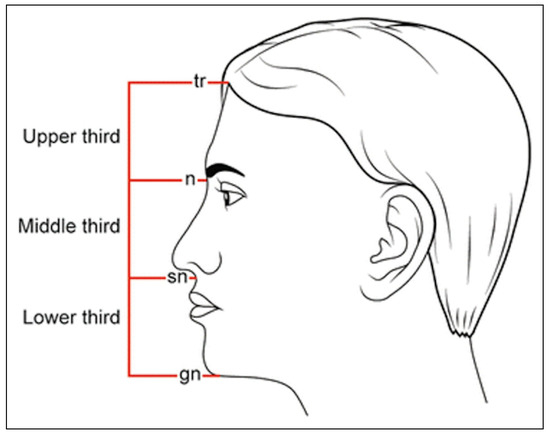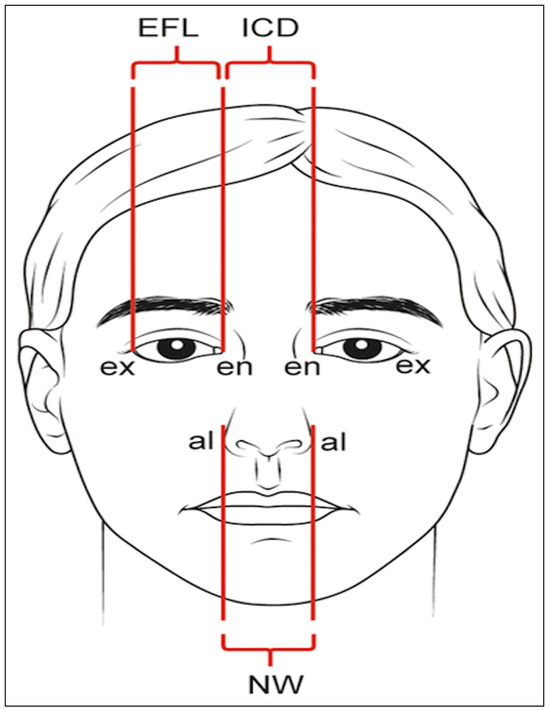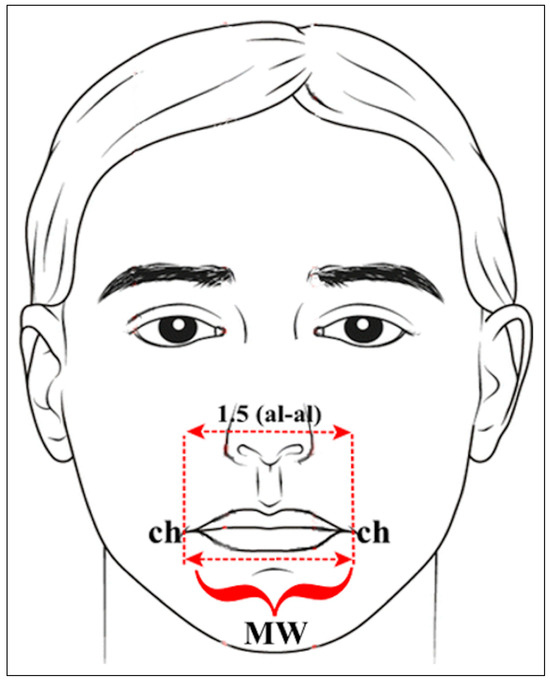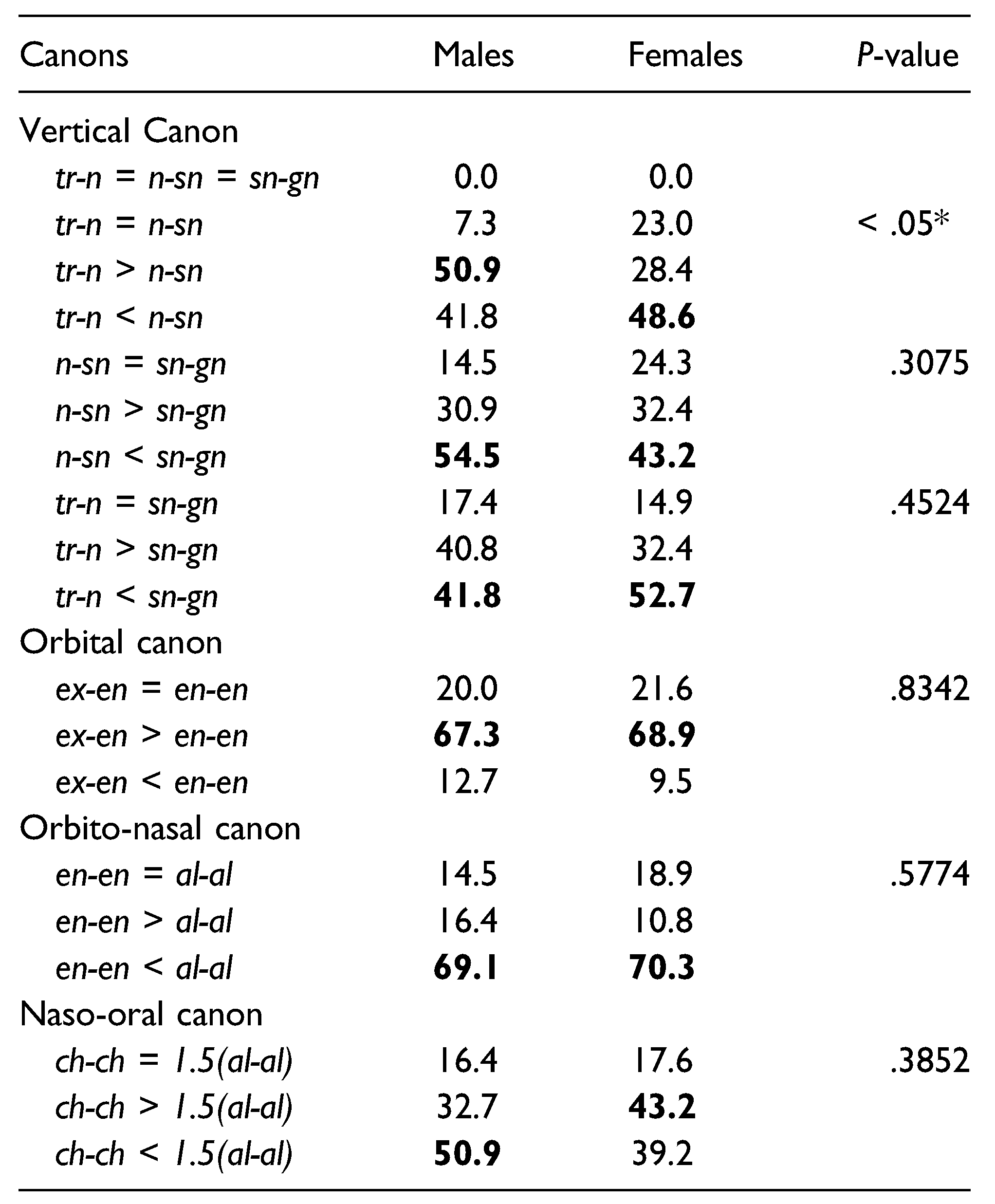Abstract
Study Design: Descriptive cross-sectional. Objective: To establish anthropometric norms and test the validity of four neoclassical canons among Kenyans of Indian descent. Methods: Using direct anthropometric landmarks, 3 vertical and 4 horizontal measurements were made on the faces of 130 adult Kenyans of Indian descent. The mean of each anthropometric measurement was calculated and a student t-test was used to identify significant gender differences. These results were compared to four neoclassical canons and the percentage of each canon and its variants were recorded. A chi-square test was then performed to assess any gender differences between these findings. Results: When comparing sexes, the anthropometric means of males were larger than those of females except for eye fissure length. In addition, only the upper third displayed sexual dimorphism. As for the neoclassical canons, the orbital canon was found to apply to 20.0% of males and 21.6% of females, followed by the naso-oral canon found in 16.4% of males and 17.6% of females, and the orbito-nasal canon present in 14.5% of males and 18.9% of females. The vertical canon was not found to be applicable to any participant. Conclusion: The facial morphometric measurements in this population differ from the described neoclassical canons since they do not apply to the majority of these individuals. Therefore surgeons should be guided by the observed populationspecific differences during reconstructive and facial aesthetic surgery.
Background
The ancient Greeks created realistic human sculptures derived from proportions that were guided by a set of “rules” known as Canons [1]. These canons are based on the hypothesis that fixed ratios exist between various parameters of the face. Leonardo Da Vinci and Albrecht Durer described the neoclassical canons. These were derived from the vertical thirds and horizontal fifths of the face which are regarded as the precursors of modern-day anthropometric indices [2]. Numerous disciplines such as orthognathic surgery, plastic surgery, and orthodontics utilize these measurements to attain a symmetrical and harmonious soft tissue relationship between the facial features [3,4,5]. In addition, they act as an essential guide for surgeons during the repair of congenital defects such as cleft lip, facial clefts, or reconstructive procedures resulting from trauma or cancer [6,7]. The value of these anthropometric measurements is accentuated in cases of bilateral trauma or disease, in which no contralateral point of reference can be used [8].
Several studies have investigated the application of neoclassical canons in numerous groups such as the American Caucasians, African Americans, and Thai among others [9,10,11]. The results reveal that facial proportions vary greatly from one another, and it is, therefore, important to note that the facial norms of one population differ in comparison to another when geographical, ethnical, and racial variations exist. In such a case, there may be a high risk of a poor surgical outcome that is not aesthetically appealing to the patient [7]. Furthermore, beauty to some point lies in the eyes of the beholder; therefore, surgical principles in aesthetic and reconstructive surgery are guided by patient expectations, facial canons, and anatomic limitations [12].
To date, normative anthropometric measurements for Kenyans of Indian descent largely remain inaccessible, and the need to develop local data cannot be overemphasized. Therefore, the current study aims to establish the baseline facial anthropometric measurements to determine the validity of 4 neoclassical canons in this population.
Materials and Methods
This study was approved by the KNH-UON Ethics and Research Committee. Participation was voluntary, and measurements were conducted only after the informed consent form was signed.
A total of 130 Kenyan of Indian descent were divided into 2 groups consisting of 66 males and 64 females who were all aged between 20 to 35 years. All anthropometric measurements were made using a digital electronic sliding caliper (VINCA DCLA-0605) with the unit system in millimeters. During data collection, the participant was asked to remain seated with the Frankfort horizontal plane parallel to the ground.
All measurements were obtained using methods described by Farkas [13]. The vertical measurements included the upper third (tr-n), middle third (n-sn), and the lower third (sn-gn). The horizontal measurements taken were the intercanthal distance (ICD) (en-en), eye fissure length (EFL) (ex-en), nasal width (NW) (al-al), and mouth width (MW) (ch-ch). These 7 anthropometric measurements produced 4 canons;
- Vertical canon (tr-n=n-sn=sn-gn) where the upper third, middle third, and lower third are all equal (Figure 1).
 Figure 1. The vertical canon. tr: trichion, n: nasion, sn: subnasale, gn: gnathion.
Figure 1. The vertical canon. tr: trichion, n: nasion, sn: subnasale, gn: gnathion.  Figure 2. The orbital and orbito-nasal canons. ex: exocanthion, en: endocanthion, al: alare, EFL: eye fissure length, ICD: intercanthal distance, NW: nasal width.
Figure 2. The orbital and orbito-nasal canons. ex: exocanthion, en: endocanthion, al: alare, EFL: eye fissure length, ICD: intercanthal distance, NW: nasal width.- Orbito-nasal canon (en-en=al-al) where the ICD is equal to the NW (Figure 2).
- Naso-oral canon (1.5(al-al) =ch-ch) where the MW is one and a half times that of the NW (Figure 3).
 Figure 3. The naso-oral canon. al: alare, ch: oral commissure.
Figure 3. The naso-oral canon. al: alare, ch: oral commissure.
The statistical analysis was carried out using SPSS (IBM statistics version 26), and descriptive statistics were computed for each variable. A student t-test was performed to compare these means between the 2 genders and a p-value of P ≤ .05 was considered to be significant. The percentages of each canon and its variants were then calculated. A chisquare test was then employed to identify significant differences between genders. The level of significance was set to p ≤ .05.
Results
Comparison of Mean Anthropometric Measurements Between Males and Females
The present study establishes the baseline facial anthropometric measurements for both male and female Kenyans of Indian descent summarized in Table 1. Comparisons reveal that all measurements in males were greater than those of females except for EFL; however, this particular finding was not statistically significant between the 2 sexes. The upper third and lower third on the other hand were both found to be significantly greater in males when compared to females (p < .05).

Table 1.
Mean anthropometric measurements of males and females.
Neoclassical Canons and Their Variants Among Kenyans of Indian Descent
The results show a diverse variation of measurements from the neoclassical canons, and the percentage of each has been summarized in Table 2. The results for the vertical canon show that the vertical thirds of the face were not equal in any case. Instead, the majority of males had a larger upper third compared to the middle third (50.9%), while females had a larger middle third than the upper third (48.6%). These results show sexual dimorphism was present in this canon (p < .05). A high percentage of both males and females (54.5% and 43.2%, respectively) had a greater lower third than middle third. In addition, the lower third was found to be greater than the upper third in both genders (41.8% of males and 52.7% of females). However, sexual dimorphism did not exist between these parameters (p > .05).

Table 2.
Characteristics of Laryngeal Fracture.
The orbital canon was observed in only 20% of males and 21.6% of females. In both genders, the EFL was found to be greater than the ICD. The results show that no sex difference was observed (p > .05).
As pertains to the orbito-nasal canon, the majority of both males and females were found to have a higher NW in comparison to ICD. A mere 14.5% of males and 18.9% of females were found to conform to this canon. There was no significant difference between males and females (p > .05).
The naso-oral canon was found to be present in 16.4% of males and 17.6% of females. In males, the MW was less than 1.5 times the NW, while in females, it was greater than 1.5 times the NW. However, no sex differences were observed between these results (p > .05).
Discussion
Facial analysis is the primary step in the evaluation of patients prior to facial surgery for aesthetic or reconstructive purposes [14]. Considering that the face is one of the most variable regions of the body, it is essential that clinicians understand the unique morphology of the patients’ ethnic group before initiating any treatment [11].
The validity of the neoclassical canons in Kenyans of Indian descent and a comparison with other populations.
The vertical canon (tr-n = n-sn = sn-gn) was not applicable in our study s since the vertical thirds were not equivalent. The majority A majority of both males (54.5%) and females (52.7%) had a larger lower third compared to the upper and middle thirds. This finding is similar to that observed in African Americans, North American Whites, Indians, Greeks, and the Chinese [10,14,15,16]. This trend was also observed in the Turkish, Egyptian, and Saudi males; however, females of these populations had a greater upper third in comparison to the other 2 vertical thirds (Table 3) [15,17].

Table 3.
Interventions and Outcomes of Laryngeal Fracture.
In the present study, the orbital canon (ex-en = en-en) was found to apply to 20% of males and 21.6% of females and therefore, was not valid in this population. Instead, majority (67.3% of males and 68.9% of females) had a greater EFL than ICD (ex-en > en-en). Similar trends have been observed in the Indian and Saudi populations [16,17]. Farkas et al. found the orbital canon to apply to 33% of North Americans and 13% of African Americans only. In the latter study, 73% of participants were found to have greater ICD than EFL [10]. In addition the Egyptians, Turkish and Chinese populations also followed this trend which stands in stark contrast to the findings of this study [15].
The orbito-nasal canon (en-en = al-al) was present in 14.5% of males and 18.9% of females. However, this canon applied to 41% of North American whites, 30% Turkish males, and 21% Turkish females which is far greater than that observed in the current population [15]. In our study, a higher NW compared to the ICD (en-en < al-al) was found to be most prevalent (in 69.1% and 70.3% males and females, respectively). These findings are in contrast to the Saudi, Turkish, Indian, African Americans, and Southern Chinese groups in which the ICD was found to be greater than the NW [3,10,15,16,17].
As pertains the naso-oral canon (ch-ch = 1.5(al-al)), it was valid in 16.4% of males and 17.6% of females. The most common variant was the narrow MW with a wide nose (ch-ch < 1.5(al-al)) in males. This variant has been found in 100% of the Vietnamese, 98.3% of Thai, and 96.7% of Singapore Chinese [18]. However, the most prevalent variant in North American whites was a wide MW with a narrow nose (ch-ch > 1.5(al-al)) observed in 60.2%, while in the present study, 43.2% of females were found to have this variant [15].
The clinical importance of these measurements and proportions is their use as critical guides during surgical reconstructive and aesthetic procedures and as an important database for forensic identification [19]. In facial surgery, determination of any unusual disproportion of the face with the help of these indices is invaluable [9]. Several studies have demonstrated the differences in parameters and indices that exist between various ethnic groups and geographical locations [10,15,16]. Sex differences in facial anthropometry have also been identified and are known to influence the parameters [17,20]. Thus, a single anthropometric norm of a population is inadequate and should not be used as a generalization across other populations [21]. By obtaining the parameters and indices for a specific group, it is possible to then tailor the reconstructive and aesthetic surgeries as near as possible to what the actual facial morphology should be in the respective ethnic groups.
Conclusion
In conclusion, the normative anthropometric measurements were established for Kenyans of Indian descent and the applicability of 4 neoclassical canons was tested. It was found that facial morphometric measurements in the study population differed from the described neoclassical canons. In addition, significant ethnic differences were observed when compared to various population groups. Therefore surgeons should be guided by the observed populationspecific differences during reconstructive and facial aesthetic surgery.
Funding
The author(s) received no financial support for the research, authorship, and/or publication of this article.
Acknowledgments
The authors would like to thank all who participated in this study which would have not been possible without their invaluable support.
Declaration of Conflicting Interests
The author(s) declared no potential conflicts of interest with respect to the research, authorship, and/or publication of this article.
References
- Edler, R.J. Background considerations to facial aesthetics. J Orthod. 2001, 28(2), 159–168. [Google Scholar]
- Vegter, F.; Hage, J.J. Clinical anthropometry and canons of the face in historical perspective. Plast Reconstr Surg. 2000, 106(5), 1090–1096. [Google Scholar]
- Jayaratne, Y.S.N.; Deutsch, C.K.; McGrath, C.P.J.; Zwahlen, R.A. Are neoclassical canons valid for Southern Chinese faces? PLoS One. 2012, 7(12), e52593. [Google Scholar]
- Seghers, M.J.; Longacre, J.J.; Destefano, G.A. The golden proportion and beauty. Plast Reconstr Surg. 1964, 34(4), 382–386. [Google Scholar]
- Mizumoto, Y.; Deguchi, T.; Fong, K.W.C. Assessment of facial golden proportions among young Japanese women. Am J Orthod Dentofacial Orthop. 2009, 136(2), 168–174. [Google Scholar]
- Jagadish Chandra, H.; Ravi, M.S.; Sharma, S.M.; Rajendra Prasad, B. Standards of facial esthetics: an anthropometric study. J Maxillofacial Oral Surg. 2012, 11(4), 384–389. [Google Scholar]
- Zacharopoulos, G.V.; Manios, A.; Kau, C.H.; Velagrakis, G.; Tzanakakis, G.N.; de Bree, E. Anthropometric analysis of the face. J Craniofac Surg. 2016, 27(1), e71–e75. [Google Scholar]
- Kim, D.C.; Mulliken, J.B. Direct anthropometry of repaired bilateral complete cleft lip. Plast Reconstr Surg. 2017, 140(2), 326e–332e. [Google Scholar]
- Farkas, L.G.; Hreczko, T.A.; Kolar, J.C.; Munro, I.R. Vertical and horizontal proportions of the face in young adult North American caucasians. Plast Reconstr Surg. 1985, 75(3), 328–337. [Google Scholar]
- Farkas, L.G.; Katic, M.J.; Forrest, C.R. Comparison of craniofacial measurements of young adult African-American and North American White Males and Females. Ann Plast Surg. 2007, 59(6), 692–698. [Google Scholar] [CrossRef] [PubMed]
- Karaca Saygili, O.; Cinar, S.; Gulcen, B.; Ozcan, E.; Kus, I. The validity of eight neoclassical facial canons in the Turkish adults. Folia Morphol. 2016, 75(4), 512–517. [Google Scholar]
- Milutinovic, J.; Zelic, K.; Nedeljkovic, N. Evaluation of facial beauty using anthropometric proportions. Sci World J. 2014, 2014, 1–8. [Google Scholar] [CrossRef]
- Koury, M.E.; Epker, B.N. Anthropometry of the head and face (ed 2). J Oral Maxillofac Surg. 1995, 53(6), 733. [Google Scholar]
- Zacharopoulos, G.V.; Manios, A.; De Bree, E.; Kau, C.H.; Petousis, M.; Zacharopoulou, I.; et al. Neoclassical facial canons in young adults. J Craniofac Surg. 2012, 23(6), 1693–1698. [Google Scholar] [CrossRef]
- Farkas, L.G.; Katic, M.J.; Forrest, C.R.; et al. International anthropometric study of facial morphology in various ethnic groups/ races. J Craniofac Surg 2005, 16(4), 615–646. [Google Scholar] [CrossRef]
- Aggarwal, A.; Sahni, D.; Lnu, S.; Lnu, H.; Jaggi, S. Sexual and ethnic differences in facial anthropometry of Northwest Indians. J Postgrad Med Educ Res. 2014, 48(4), 171–182. [Google Scholar]
- Al-Sebaei, M.O. The validity of three neo-classical facial canons in young adults originating from the Arabian Peninsula. Head Face Med. 2015, 11, 4. [Google Scholar]
- Le, T.T.; Farkas, L.G.; Ngim, R.C.K.; Levin, L.S.; Forrest, C.R. Proportionality in Asian and North American caucasian faces using neoclassical facial canons as criteria. Aesthetic Plast Surg. 2002, 26(1), 64–69. [Google Scholar]
- Garandawa, H.I.; Nwaorgu, O.G.B.; Oluwatosin, O.M. Morphometric nose parameters in adult Nigerians. Internet J ORL. 2009, 10(2). [Google Scholar]
- Osunwoke, E.; AmahTaria, -F.; Obia, O.; Ekere, I.M.; Ede, O. Sexual dimorphism in facial dimensions of the Binis of South – Southern Nigeria. Asian J Med Sci. 2011, 3(2), 71–73. [Google Scholar]
- Porter, J.P.; Olson, K.L. Anthropometric facial analysis of the African American woman. Arch Facial Plast Surg. 2001, 3, 191–197. [Google Scholar] [CrossRef]
© 2022 by the author. The Author(s) 2022.


